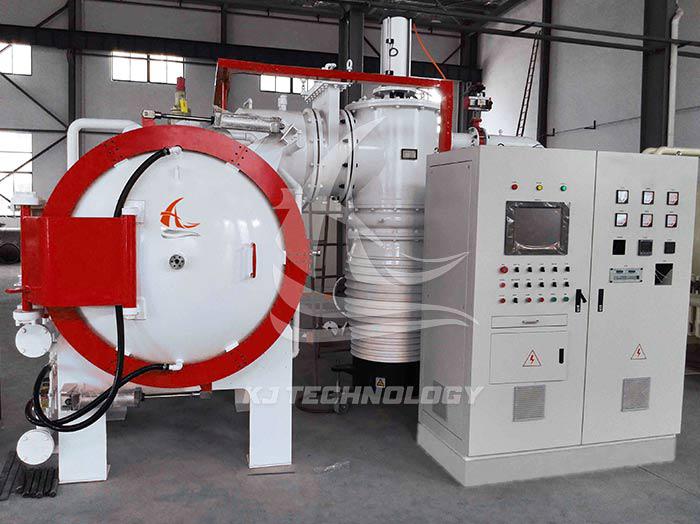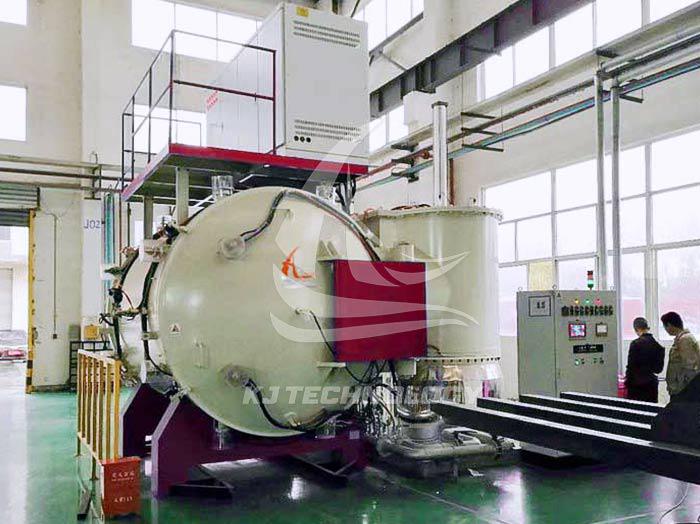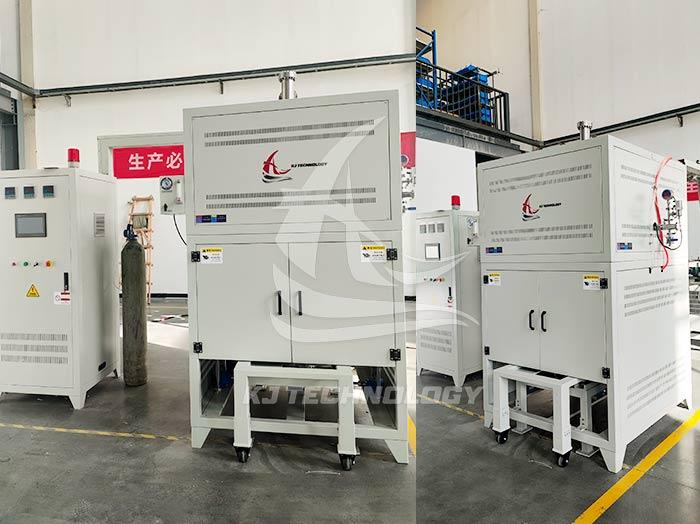Application of Pressure Sintering Furnace in Ceramic Industry
 07-09-2025 Author: KJ technology
07-09-2025 Author: KJ technology
The application of pressure sintering furnace in the ceramic industry is extensive and critical. It achieves densification of ceramic materials through high temperature and high pressure environment, significantly improving the mechanical properties, thermal properties and chemical stability of products. The specific application scenarios and technical advantages are as follows:
1. Typical application scenarios
Preparation of high-performance structural ceramics
Silicon nitride ceramics: Through two-step pressure sintering (first low-pressure exhaust hole, then high-pressure densification), the fracture toughness is increased from 8.9MPa · m ¹/² to 12.6MPa · m ¹/², and the bending strength exceeds 830MPa. It is used to manufacture mechanical components such as ceramic bearings and cutting tools.
Silicon carbide ceramic: forms a honeycomb structure under 2MPa nitrogen and 1900 ℃ conditions, with a 40% increase in high temperature resistance, suitable for extreme environments such as aerospace engine turbine blades and rocket combustion chamber liners.
Aluminum oxide ceramics: Pressure sintering can eliminate pores and increase light transmittance to over 85%, used for transparent ceramic components such as laser windows and high-pressure sodium lamp tubes.
Functional Ceramics and Electronic Materials
Piezoelectric ceramics: such as barium titanate (BaTiO ∝) based piezoelectric ceramics, pressure sintering precisely controls the microstructure and phase composition, improves piezoelectric performance by 30%, and is used in electronic devices such as sensors and transducers.
Semiconductor ceramics: sintered under specific atmospheres (such as nitrogen and argon), controlling oxygen partial pressure, avoiding component segregation, and improving material electrical properties.
Bioceramics and Medical Devices
Hydroxyapatite (HA) ceramics: pressure sintering reduces abnormal grain growth, with biocompatibility up to ISO 10993 standard, used for artificial bone and dental implants.
3D printed silicon nitride implants: After pressure sintering, their biological activity and mechanical properties match human bones, and have entered the clinical validation stage.
Ceramic based composite materials
Carbon fiber reinforced alumina ceramics: Pressure sintering promotes the bonding between fibers and matrix interface, increasing bending strength by 50%, used for high-performance structural components in aerospace.
Gradient functional ceramics: By gradually changing the raw material ratio and sintering process parameters, a gradient transition from the ceramic side to the metal side is achieved, which is used in fields such as thermal barrier coatings and electronic packaging.
2. Analysis of Technical Advantages
Enhancement of densification efficiency
Pressure sintering promotes particle rearrangement and plastic flow through external forces, reducing the porosity from 5-10% in conventional sintering to below 0.1%. For example, silicon nitride ceramics sintered at a pressure of 8MPa can achieve a density of 99.5%, which is much higher than the 80% -87% sintered at normal pressure.
Grain refinement and performance optimization
High pressure environment suppresses abnormal grain growth, such as the homogenization of grain size (average 1 μ m), a 15% increase in hardness, and a 40% increase in wear resistance of silicon carbide ceramics after pressure sintering.
Complex shapes and near net forming
Combined with mold design, pressure sintering can achieve near net forming of ceramic components, reducing subsequent processing steps. For example, special aerospace components are directly formed through pressure sintering, which increases material utilization by 30%.
Atmosphere control and ingredient precision
Sintering in a vacuum or inert gas environment (such as nitrogen or argon) to avoid oxidation and contamination. For example, during the sintering of semiconductor ceramics, the oxygen partial pressure control accuracy in the atmosphere reaches ± 1ppm, ensuring stable electrical properties of the material.
3. Industry application cases
EADS
NASA spacecraft bearings use pressure sintered silicon nitride ceramics, which extend their service life by 50% and maintain stability under temperature differences of -270 ℃ to 1200 ℃.
Domestic aircraft engine turbine blades achieve high-temperature creep resistance at 1700 ℃ through pressure sintering technology, and their fatigue life is increased by 2.3 times.
New energy vehicles
The bearings of the BYD 800V high-voltage platform motor are made of pressure sintered silicon nitride ceramics, which support high-speed operation at 20000rpm with a density only one-third of that of metal, but can withstand high temperatures of 1600 ℃.
In the solid-state battery production line of Ningde Times, the pressure sintered silicon nitride ceramic substrate has a density of 99.8% and a hardness of 23.3GPa, becoming a "safety fortress" for battery cell packaging.
Industrial manufacturing
The hydraulic system of Sany Heavy Industry excavator adopts pressure sintered silicon nitride ceramic seals, which have a wear resistance life five times that of traditional metal parts, and the maintenance cycle has been extended from 3 months to 18 months.
After using pressure sintered silicon nitride ceramics for high-temperature valves in a certain chlor alkali enterprise, the service life was extended from 6 months to 24 months, and the cost was reduced by 75%.








